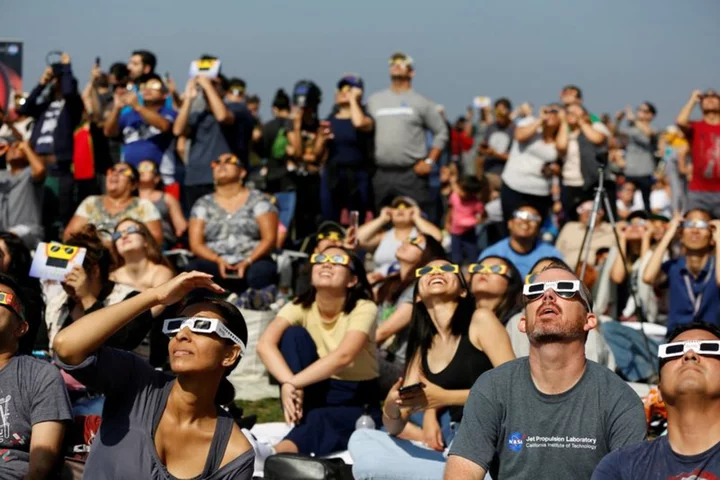By Will Dunham
WASHINGTON Millions of people in the Americas will be in a position to witness an astronomical treat on Oct. 14 with a solar eclipse in which - weather permitting - the moon will be seen passing in front of the sun.
The eclipse is due to be visible along a path covering parts of the United States, Mexico and several countries in Central America and South America.
Here is an explanation of the type of solar eclipse that will occur and where it will be visible.
WHAT IS AN ANNULAR SOLAR ECLIPSE?
A solar eclipse happens when the moon journeys between Earth and the sun, blocking the view along a small path of Earth of some or all of the sun's face as it passes. The one that will occur on Oct. 14 is a type called an "annular solar eclipse." This occurs when the moon passes between Earth and the sun at a time when the moon is at or close to its farthest point from our planet. It does not completely obscure the face of the sun, unlike in a total solar eclipse.
WHY DOES IT LOOK LIKE A RING OF FIRE?
Because the moon is farther than usual from Earth during an annular solar eclipse, the moon will not completely obscure the sun, instead looking like a dark disk superimposed atop the sun's larger, bright face in the sky. As a result, the eclipse will momentarily look like a ring of fire surrounding the dark disc of the moon. A total solar eclipse is due to occur on April 8, 2024, passing over Mexico, the United States and Canada.
WHERE WILL IT BE VISIBLE AND WHAT IS ITS PATH?
According to the U.S. space agency NASA, the path in the United States where the maximum obscuring of the sun will occur on Oct. 14 runs through parts of several states beginning at 9:13 a.m. PDT (12:13 p.m. EDT/1613 GMT) in Oregon, then California, Nevada, Utah, Arizona, New Mexico and Texas. The path then crosses over parts of Mexico, Guatemala, Belize, Honduras, Nicaragua, Panama, Colombia and Brazil before ending at sunset in the Atlantic Ocean. People in much larger parts of North America, Central America and South America will be able to see lesser obscuring of the sun - still an impressive sight.
HOW BIG ARE THE EARTH, MOON AND SUN?
The moon will nearly cover the sun's face, as visible from Earth, only because the moon - in actuality much smaller than the sun - is so much closer to our planet. The moon's diameter is 2,159 miles (3,476 km), compared to the sun's diameter of about 865,000 miles (1.4 million km) and Earth's diameter of 7,918 miles (12,742 km).
WHAT IS THE SAFEST WAY TO WATCH AN ECLIPSE?
Experts warn that it is unsafe to look directly at the bright sun without using specialized eye protection designed for solar viewing, risking eye injury. Because the sun is never fully blocked by the moon in an annular solar eclipse, it is never safe to look directly at it without such eye protection. Viewing it through a camera lens, binoculars or telescope without making use of a special-purpose solar filter can cause severe eye injury, according to these experts. They advise using safe solar viewing glasses or a safe handheld solar viewer at all times during an annular solar eclipse, noting that regular sunglasses are not safe for viewing the sun.
HOW DO SOLAR ECLIPSES DIFFER FROM LUNAR ECLIPSES?
Lunar eclipses occur when Earth is positioned between the moon and the sun and our planet's shadow is cast upon the lunar surface. This leaves the moon looking dim from Earth, sometimes with a reddish color. Lunar eclipses are visible from half of Earth, a much wide area than solar eclipses.
(Reporting by Will Dunham, Editing by Rosalba O'Brien)









